Korg
Volca Beats Snare
Analysis
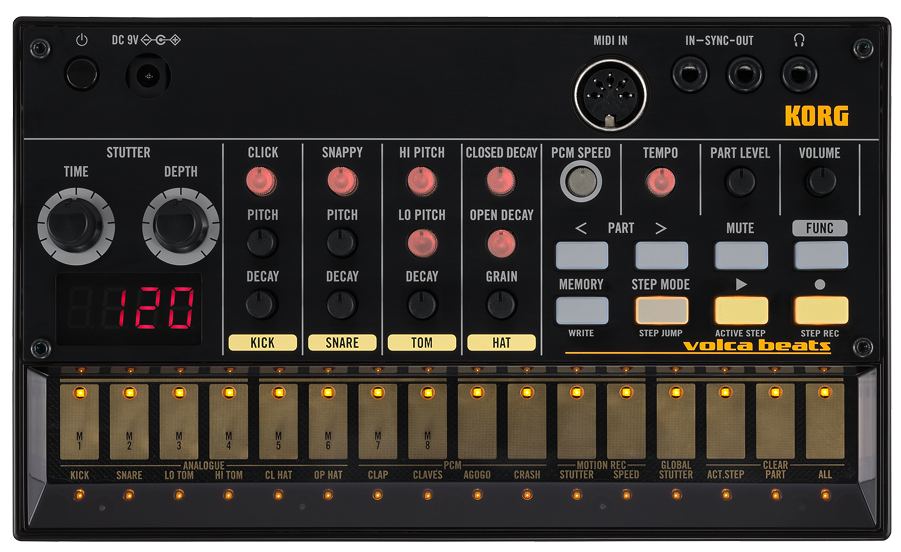
The Volca Beats snare kind of sucks. Korg’s designers may have expertly
and earnestly designed the snare to sound more natural than the
electronic snare of the Roland TR-808 or TR-909, but many users of analog drum
sounds want an unnaturally snappy and punchy snare. Several attempts to
mod the snare circuit have been made. The most common mod is to add a
100nF capacitor to the empty C78 pads on the PCB. Another mod increases
the noise
component, sometimes using a 10K pot to allow adjustable noise level.
I added a 100nF capacitor to the empty C78 pads and it improved the
quality of the snappy component, but the snare remained underwhelming.
In order to make meaningful modifications to the snare circuit it would
help to have a schematic.
I reverse engineered the Volca Beats snare drum circuit and determined
semiconductor part numbers by looking up SMD codes. The
result is a
schematic of the Volca Beats
Snare drum circuit. It is likely there
are errors, although I'm fairly confident of the
fundamentals. Resistor values were printed on the resistor
packages. Capacitor values were not determined (I wasn't inclined to
desolder and measure every capacitor...). Resistor and capacitor
references are impressively comprehensive considering the board
density, however some references are not printed on the silkscreen.
First, a little preamble: I've compared 3 different Volca Beats. They
all sound a little bit different. For example, there was a noticeable
difference in the maximum snare decay time between my Beats and my
friend’s machine. Additionally, the minimum and maximum pitches were
slightly different. Based on the SMD codes, the resistors are most
likely 5% tolerance and the capacitors are likely in the 10-20% range.
In the same way no two 808s sound exactly the same, it would seem the
same applies to the analog sections of the Volca Beats.
For a detailed analysis of snare drum synthesis, the venerable Gordon
Reid has the final word. Briefly, a synthesized snare drum consists
of a 'membrane' component and a 'snappy' component. Using the TR-808
snare as an archetype, the membrane component is synthesized using a
'T-Bridge' resonator whose frequency and decay are determined by the
resistor and capacitor values in the feedback network:
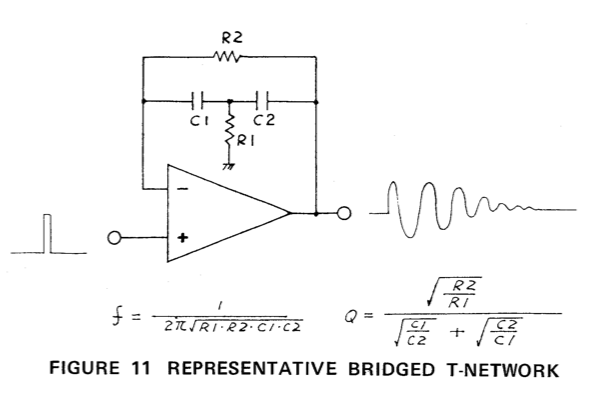
(T-bridge resonator from TR-808
service manual)
In the case of the TR-808, the membrane component consists of a mixture
of two T-bridged networks. One resonates at about 180 Hz and the second
one resonates at about 330 Hz. The 'tone' control mixes between the two
resonators.
The snappy component consists of white noise whose amplitude is
controlled by a simple VCA and envelope generator. The 'snappy' control
attenuates the trigger into the noise envelope generator. The membrane
and snappy components are summed together to produce the snare sound.
The Volca Beats snare circuit seems to follow a similar topology: a
single variable pitch T-bridge resonator is combined with a white noise
pulse to produce the characteristic electronic snare. The problem is
that the Volca snare sounds terrible, at least relative to the TR-808
and TR-909 archetypes. Why is this?
MEMBRANE
The Volca snare consists of a single resonator with a variable pitch (IC10C) .
In contrast, the TR-808 snare consists of two resonators with fixed
pitches that are mixed together with the tone control. I measured
the Volca snare's membrane pitch to be variable between 250 Hz and 570
Hz. Based on the T-bridge frequency formula, the feedback capacitors
are likely around 10 nF. To my ear, the Volca snare membrane frequency
is too high. Again, using the TR-808 as the archetypal electronic
snare, my impression is not inaccurate: the 808 snare membrane
frequency varies between about 170 Hz and 330 Hz. But here is an
interesting aside: the
value of the feedback capacitors were changed over the course of 808
production. The original values specified in the service manual
schematic produced frequencies of 250 Hz and 500 Hz, which are very close to the range of the Volca snare. However, the majority of stock 808s (at least the 4 that I
measured) have a lower frequency range, The frequency of the Volca's
T-bridge network seems to conform to the formula in the TR-808
service manual. Changing R183 to 10K changes the membrane frequency
range to about 164 Hz to 232 Hz. To my ear, this produces a more
satisfying snare. Further changes could be made to the Volca
snare to get it to better conform to the frequency range and resonance
of the TR-808 snare. In fact, it might be possible to produce the same membrane sound as the
TR-808 with the same frequency range and resonance by changing the two
resistors and two capacitors that make up the network. However, unlike the
TR-808 snare, the Volca snare has a variable decay. The decay is
determined by the amount of feedback controlled by the decay pot, not
entirely dissimilar to the decay circuit of the TR-808 kick drum. The
snare decay becomes important later...
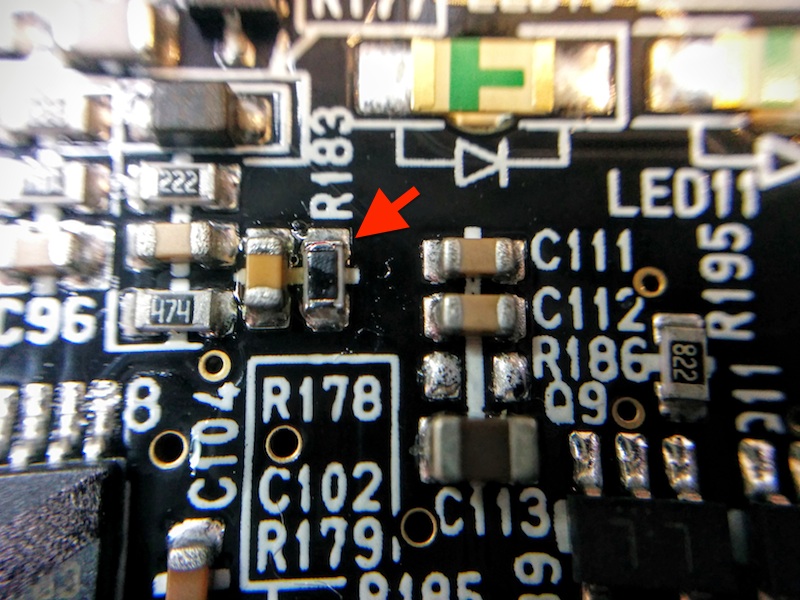
(increasing R183 to 10K reduces snare membrane frequency)
SNAPPY
Now onto the snappy component. The first major revelation about the
Volca snare is that the white noise seems to be generated digitally.
What looks like a train of random high frequency pulses from the
microcontroller is filtered into white noise by IC9B. IC9B forms a
second-order low pass filter, at least according the bible
of active filter design techniques. Changing the frequency response
of this filter will alter the character of white noise.

Replacing R134 with a lower resistor value (eg. 1.5K) or even a
10K potentiometer will increase the gain and change the frequency
response of the filter. Modifying the noise filter has been previously described. I measured an increase in the noise output from about 1.3V to 3.3V when R134 was changed to 1.5K. Other changes to the noise
filter could also be done to change the character of the Volca snare's
noise source. It seems the noise is also used for the hats and the toms.
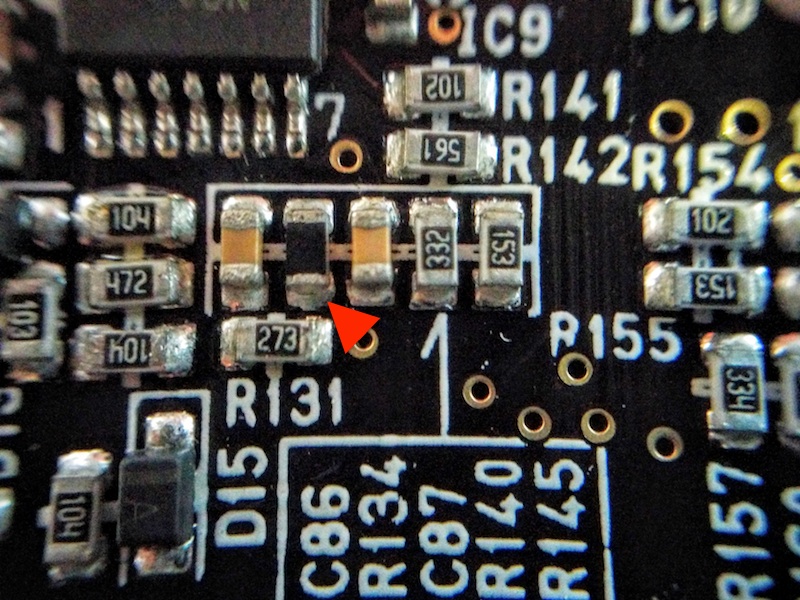
(R134, replaced with 1.5K resistor)
Now, how is the envelope generated for the snappy component? This is
where the Volca snare makes an interesting departure from the TR-808
snare. The TR-808 has a fixed membrane decay and an independent fixed snappy decay. The
Volca snare has a variable decay, which works by varying the amount of
feedback of the T-bridge resonator. As far as I can tell, the output of
the membrane component is fed into the snappy VCA through C91. The membrane component of the Volca snare
is used to shape the white noise that makes up the snappy component.
Thus, the snappy decay is determined by the membrane decay. This seems
like a clever and efficient use of the variable membrane decay to
control the snappy decay without requiring independent snappy envelope
circuitry. But, to many people's ears, the Volca snare's snappy
component sounds fucking awful. It's 'distorted' and 'grainy' and
here's why: the output of the membrane is buffered and rectified by
IC9A but it isn't filtered.
Here's what it looks like on a scope at the cathode of D14:
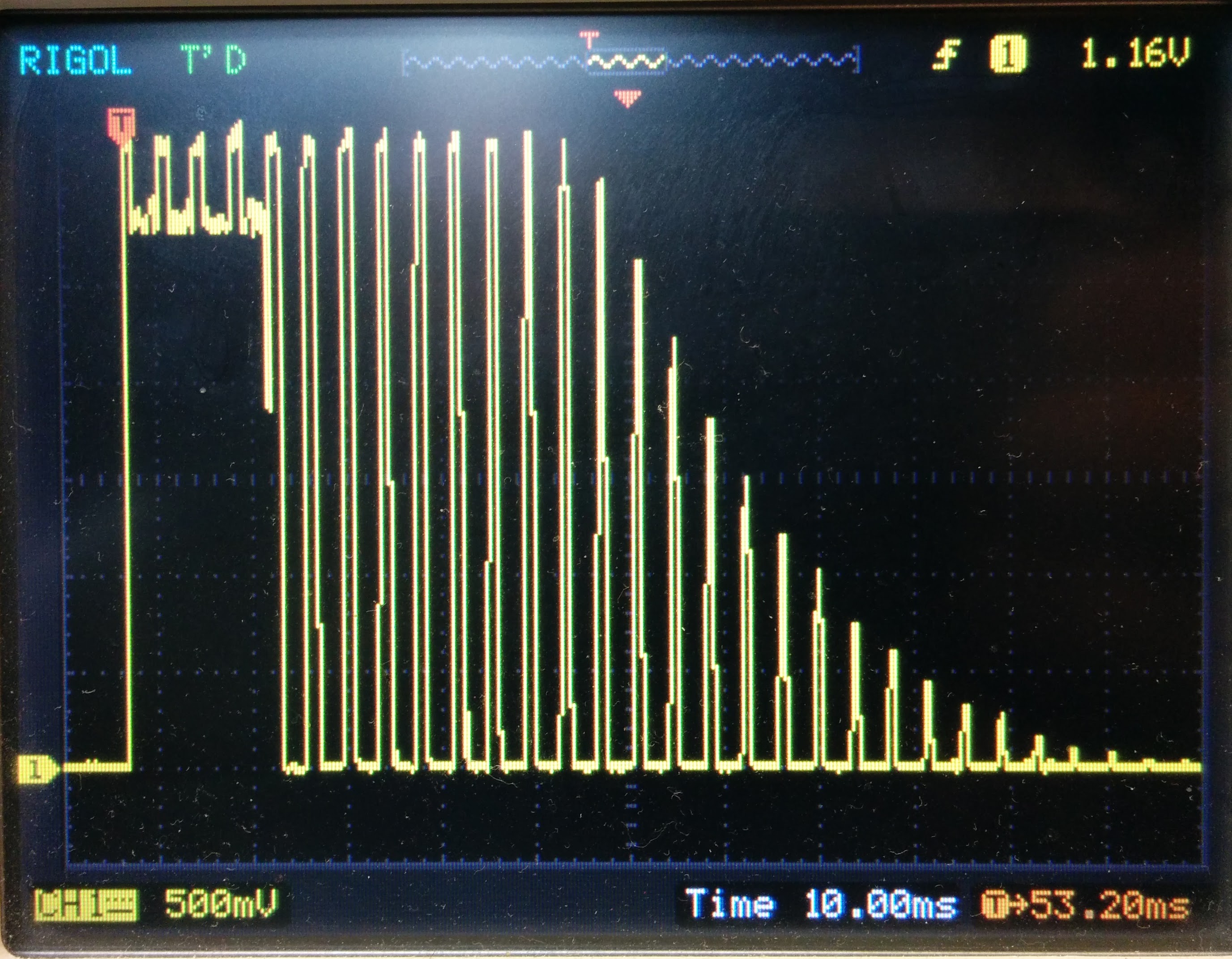
(snare snappy envelope without C78)
The envelope is chopped up by the frequency of the membrane (the first
~15 ms pulse is the trigger signal coming through D13). This amplitude
chopping is likely the cause of the ‘graininess’ and 'distortion' in
the snare snappy that many users (myself included) complain about,
which is especially prevalent with longer decay settings. The noise is
being chopped up at 250 - 560 Hz, dependent on the snare pitch. C78,
the legendary missing capacitor on production Volcas, has the job of
partially filtering out the membrane frequency:
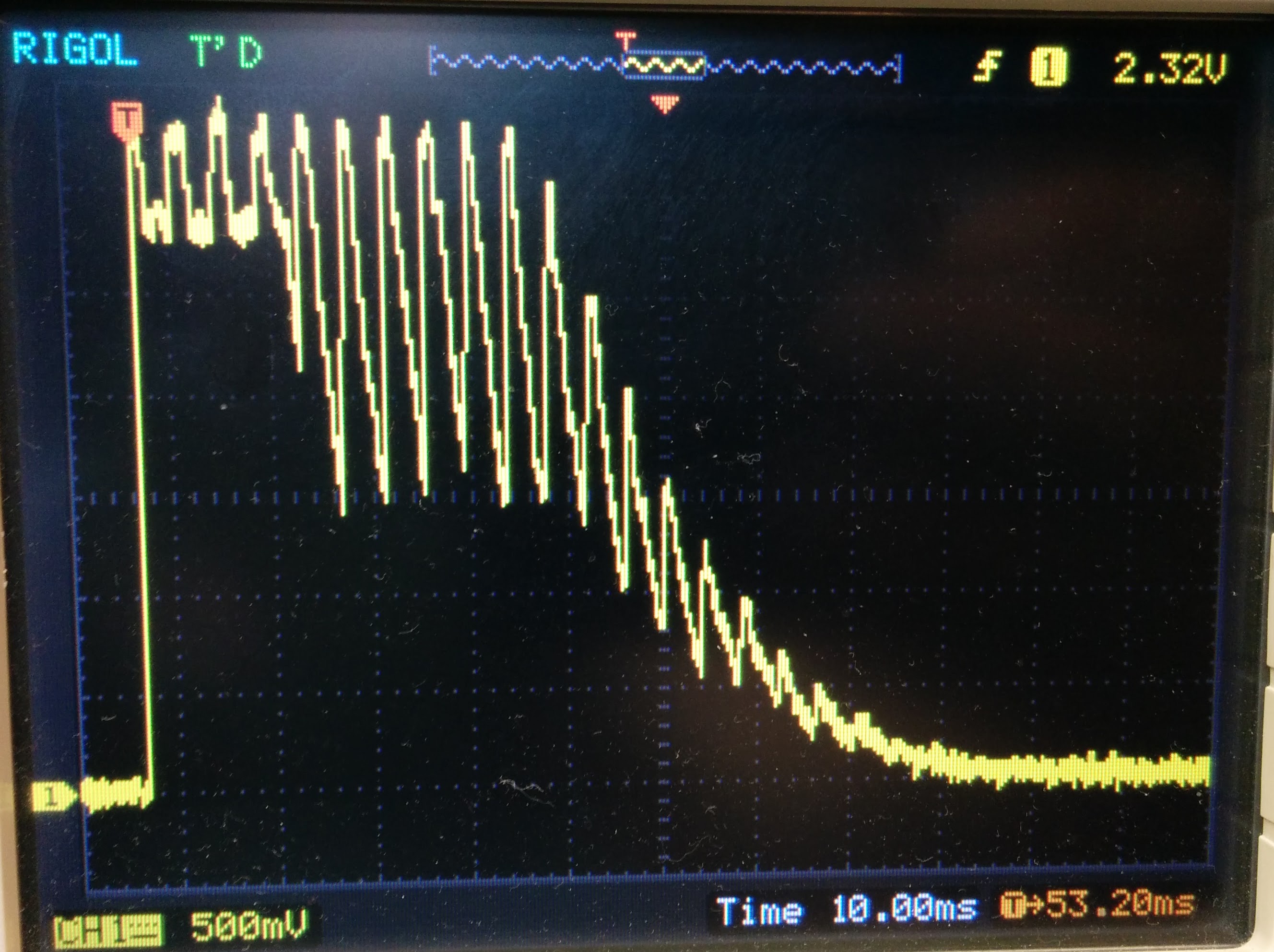
(snare snappy envelope after 100 nF C78 installed)
A 100nF capacitor soldered to the C78 pads doesn't completely get rid
of the membrane frequency component, but at no point does the envelope
return to 0V until the end of the decay. The result is a much more
pleasing sounding noise that is less 'grainy'. A smooth contour can be
had by increasing C78 to 470 nF, however this produces a noticeable
snappy decay when the snare decay is 0 and just the gate pulse is
triggering the snappy VCA. There isn't much of an audible difference:
100 nF seems to be the 'sweet spot' for filtering out the membrane
frequency without adding an excessively long tail to the gate
pulse. Alternatively, a 47 nF capacitor can be soldered across
the 100K resistor in the feedback network of IC9A to produce a nicely
shaped contour with almost none of the frequency component apparent
from the membrane. This does result in a slightly longer minimum decay,
though.
Why Korg left C78 off the production Volcas is up for debate. To many
users ears, it improves the quality of the snappy noise and it was
clearly designed for this purpose. It does produce in a slightly longer
minimum snappy decay.
DECAY
The amount of decay available on my Volca's snare drum is satisfactory,
but two other Volcas I looked at had noticeably shorter maximum decay
times. The adjustable feedback that provides decay control is handled
by IC10D. Making changes here (eg. increasing gain of feedback
amplifier by increasing R163) will increase the maximum decay time.
CONCLUSION
To my ears, the Volca snare suffers from two problems:
1. The membrane frequency range is too high.
2. The snappy noise is of low quality, suffering from an unpleasant 'graininess' or 'distortion'.
Both of these issues can be remedied by just two resistor changes (R134
for amplitude/frequency of noise and R183 for membrane frequency)
and addition of C78 (100 nF). The result is not quite as good as the
taught and snappy TR-808 snare, but is a vast improvement over what the
Volca offers out of the box.
It helps to have a hot air rework station to do these mods.






